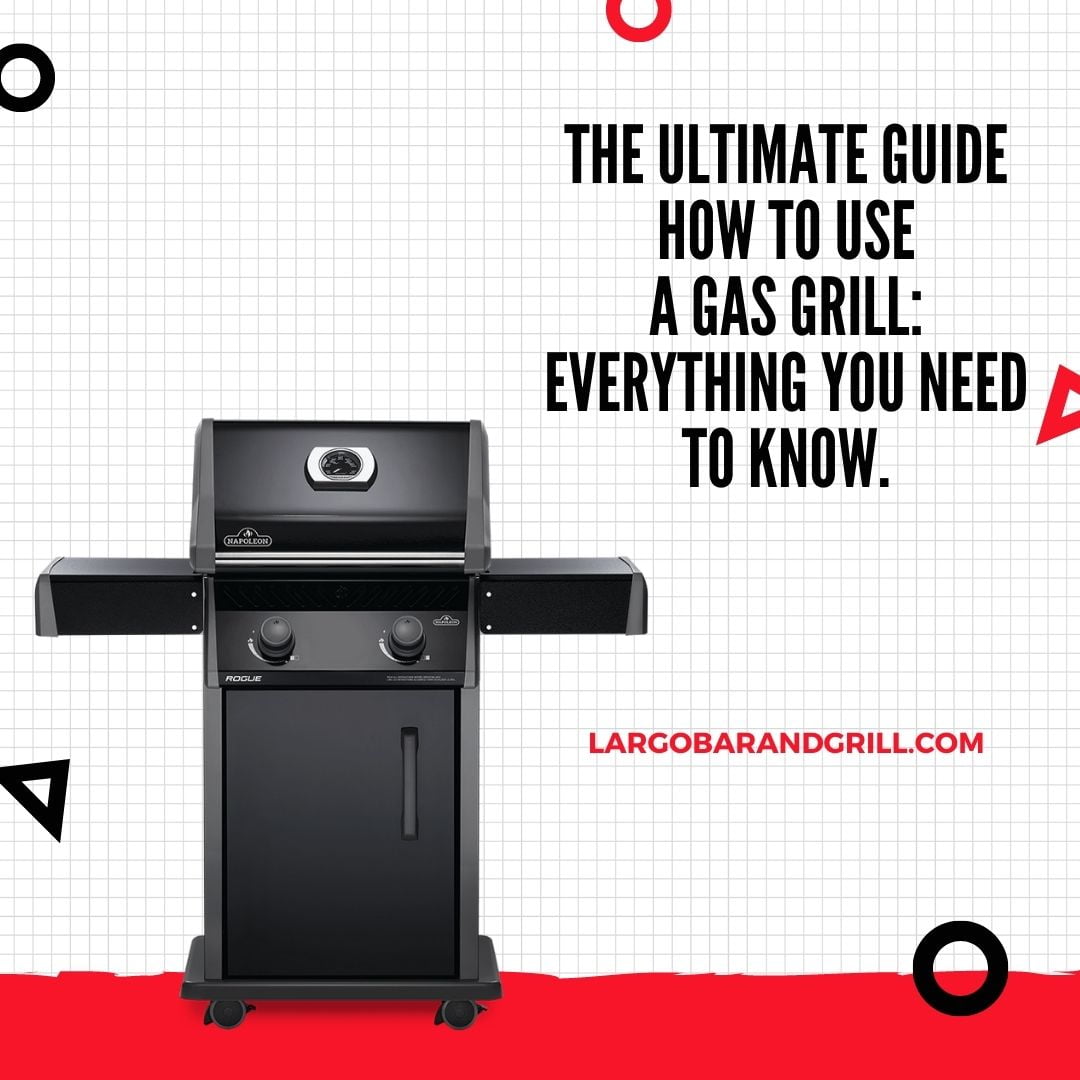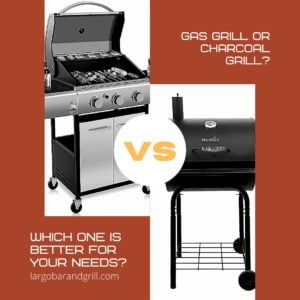Disclaimer: There are affiliate links in this post. At no cost to you, I get commissions for purchases made through links in this post.
Summertime is the perfect season for grilling out with family and friends. If you’re like most people, you probably use a charcoal grill for your outdoor cooking needs. However, if you have a gas grill, you may be wondering how to use it to its full potential. In this blog post, we will give you some tips on how to use your gas grill like a pro. So, read on and get ready to start cooking!
Gas is one of the types of heating sources used for cooking outdoors and it’s gaining more and more popularity both with experts and home users because it provides advantages compared to other types of heating sources.
The first advantage is that you can cook quickly, especially if you opt for an electronic ignition model (just push a button or turn a switch), which makes your life easier as there’s no need to fiddle around looking for some matches or lighters; and another benefits.
Not to fear; we’ll walk you through the process of learning how to use a gas grill as a beginner in this comprehensive guide. Read this guide to gain the knowledge necessary to get started in the best possible manner.
What is a gas grill
A gas grill is a grill powered by propane or natural gas, instead of charcoal or electricity found on traditional charcoal grills. In most cases, the burners are located underneath enameled cast-iron cooking grates where food can be placed.
This allows for direct and indirect cooking methods as well as smoking if desired, depending on what you’re grilling up.
Gas grills are very similar to charcoal grills, but are much easier to use. A gas grill uses propane or natural gas for fuel and is turned on and off with a knob. The heat source in the grill is either an electric heating element or burners located underneath the grate.
How Gas Grills Work
The heat comes from burning the fuel in the line that leads to each burner under your grate.
Each time you turn on a burner knob, a valve opens letting gas through to the burner tube underneath the grate where it mixes with oxygen from the air holes in the tube.
The gas flame heats up, causing the metal grate to heat up, so food can cook on it. How does each burner produce different amounts of heat? Imagine what would happen if you turned on your kitchen stove and all four burners lit at once.
A typical gas grill has four major parts: The hood, which houses the battery-operated ignition system; the burners, which are located underneath removable steel or cast-iron grill grates; one or more drip pans positioned above the burners to catch any cooking oils or fats that drain through the grate bars; and finally, at least one warming rack above the drip pan(s), although some models have two warmers instead of just one.
A gas grill is filled with propane before its first use, so preheat the burners for five minutes to activate the built-in safety mechanism that keeps you from accidentally lighting your grill when it hasn’t been filled or turned on.
When you’re ready to start grilling, push down on the knob located in front of the control panel and stick a long-handled lighter inside to unleash a high flame which ignites all burners at once.
The best type of lighter fluid to use is petroleum jelly, because it won’t evaporate as quickly as other types of fuel. Once ignited, turn off this high flame by pushing down on the ignition knob again.
To get an even heat distribution throughout your entire cooking surface, position the front and rear burners at medium. Turn all three top-side knobs to their highest setting for 15 minutes to preheat the grill grates as well as any warming racks that your model might have.
When it’s time to start cooking, move any available burner(s) down to “medium low” or even “low” depending on how hot you want those surfaces to get.
The food you’re grilling cooks more slowly over a low heat source, but if the grill gets too hot, you run a greater chance of burning whatever you put on there – especially delicate fare like boneless chicken breasts and fish fillets.
Steps for How to Use a Gas Grill
Preparing the grill for use
1) Make sure you have enough fuel. Most people tend to think they always need more than what they actually do, so only add propane once the tank registers half full.
2) Make sure your connections are secure and that there aren’t any leaks anywhere in the system. How can you tell if there’s a leak? Turn on one of the burners until it produces a steady blue flame, then turn the knobs of all the burners. If you hear a series of clicks or if any one burner shuts off, there is probably a leak at that connection. A gas grill should not be operated with any leaks. How do you fix it? Turn off your gas supply and find the connection where there’s a leak (you may have to replace some parts).
3) Preheat your grill for 10-15 minutes before cooking so the food will sear properly when it makes contact with the grate. How can you tell when your grill is hot enough? The metal becomes very hot to the touch, but not so hot that it would burn your hand. When you hold your hand just above grate level, it should feel quite warm.
Adjust the grates
Adjusting your grates is very simple, there are two types of adjustments when it comes to grates. The first is raising the grate up from the surface of the grill.
This helps when cooking thinner food, such as steaks or slices of vegetables. Raising it higher will allow more heat to meet your food and help cook it a little faster.
How to cook on a gas grill
After assembling the grill, attach the propane tank with regulator to pre-heat the grill with all burners on high for 10 minutes before lowering it too medium. How you use your gas grill at home depends on how many people you are cooking for.
You can cook vegetables, meats and seafood using the same heating methods so whatever kind of food you choose, do not overcrowd the grilling area. To set up a direct heat zone (high), remove one or two burner caps (depending on your specific model) and keep them away from the rest of the burners.
Bring the temperature down by turning off half of your grill’s gas supply by closing one of its valves; this is known as an indirect heat cooking method. Turn the remaining burners to medium and place your meats on the cooking grates.
How you use your grill is not only about the type of food but also how thick it is. If the meat or vegetables are too thick, rotate them every couple of minutes so that they can cook thoroughly.
Some recipes that can be cooked on a gas grill are boneless rib eye steak, grilled vegetables, and grilled shrimp skewers.
Cleaning up after cooking with a gas grill
Cleaning up after cooking with a gas grill is much easier than cleaning up after cooking with a charcoal grill. Grill grates, burner tubes, and the interior surfaces of your gas grill will need attention before you use it again.
Cleaning your gas grill is more involved than simply brushing off the ash that accumulates at the bottom of an unused charcoal grill.
The best way to clean your grill is to start when it’s still warm and use tongs and non-abrasive scrubby pad or wire brush. When preparing food, make sure meat is at least 4 inches from flames; otherwise, it will taste like burnt steak. To prevent your food from sticking, you can oil the grate.
How you clean your grill depends on its construction material. A stainless-steel model has two heat zones for direct and indirect heat cooking methods which makes it easy to clean up using a wire brush after each use.
A porcelain-coated cast iron surface is easier to clean compared with other materials because it requires no pre heating so simply wipe it with paper towels or a moist cloth before storing away, making sure there is no trace of grease left behind.
Tips and tricks to make your gas grilling experience more enjoyable
If you are new to using a gas grill, it is recommended that you not cook during the first use. To prepare the grill for cooking, follow these simple steps:
1) Remove any debris or old grease from inside of your grill’s stainless-steel lid and firebox. If there is too much debris, try using tongs to remove as much as possible.
2) Using a flashlight, if necessary, inspect all hoses connected to your propane tank or natural gas line. Make sure everything looks intact and replace parts if needed.
3) Check both sides of your burner tubes for accumulations of grease or food particles by removing the protective mesh screens on each side. This should be done every time you use the grill. If there is a lot of debris, it may be necessary to scrape off the accumulations using a long-handled metal brush.
4) Finally, place your cooking grates onto the grill and adjust as needed so they fit properly without being too loose or too tight.
5) In order to ensure that your gas grill is as safe as possible for future use, check all connections between hoses and make sure they are secure before turning on any propane control valves (if applicable).
6) Now you can light up one burner at the lowest heat setting and cook something very slowly over low heat. When finished, turn it off completely and disconnect your propane tank or natural gas line from the regulator.
FAQs
Clean it at least once a month, after each use.
Place the hot grill on a heat-proof flat surface and spray with oven cleaner or use a stainless-steel cleaner. Let stand for 10 minutes. Using tongs and a wire brush, scrape grill to remove burned-on food residue Rinse thoroughly before continuing to cook
In general, one pound of propane will last about 2 hours.
When the flame emits small blue flames from around the burners If you have any questions about how to care for your gas grill, or any other grill, contact a company specializing in barbecue equipment. How do you find one of these companies?
Any kind of vegetable oil will work. If your grill tends to stick, it’s best not to use any kind of meat or cheese on it because the sugars in these products tend to cause sticking
Turn knobs to bring flames higher or lower. How low the flames are will determine how quickly your food cooks. Once cooked, take off the grill and let stand 10 minutes before serving. The longer time spent on high heat results in seared juices in the steak which gives it that great grilled flavor
This depends somewhat on personal preference, but somewhere between 1/4″ – 3/8″ is a good place to start. How often do you turn the food?
Conclusion
It’s easy to get started with a gas grill if you follow these simple steps. So, there you have it! If you’re looking for a quick and easy way to prepare your food without having all the mess of cooking indoors or with an oven.
A gas grill is perfect for any occasion and will make grilling easier than ever before. Follow these simple guidelines when using a gas grill and be prepared to enjoy some delicious meals in no time at all!
Read more
- 🔥 Lodge Pre-Seasoned Cast Iron 5-Piece Set Review: The Last Cookware Set You’ll Ever Need
- 18-Inch Portable Charcoal Grill Review: The Affordable Kettle Grill That Surprises Everyone
- Are Nugget ice makers worth it?
- How does the KitchenAid cold brew coffee maker work?
- What cut of steak is the best?
- How to choose the best espresso machine under 100
- What is the best espresso machine under 200?
Related Posts
Top 10 Best Gas Grills For Your Home And Backyard
Disclaimer: There are affiliate links in this post. At no...
Read MoreHow To Select The Best Griddle For Your Gas Grill
Disclaimer: There are affiliate links in this post. At no...
Read MoreGas Grill Or Charcoal Grill? Which One Is Better For Your Needs?
Disclaimer: There are affiliate links in this post. At no...
Read MoreWhy Trust Us
You will find what you are looking for at Largo Bar and Grill. From classic to luxury brands, you'll find both. We will help you to select appliances that fit your needs, budget and lifestyle. Whether you want to stop by to learn more — or plan to make a major purchase — we’ll treat you like family and assist you every step of the way. Shop with us today to receive friendly and experienced help along the way.




